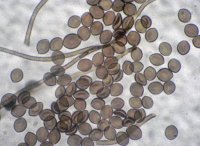Chaetomium Species
Chaetomium species are found worldwide in soil, dung, or decaying plants. Most species are prolific producers of the enzyme cellulase that breaks down cellulose. Destruction of paper and other materials containing cellulose (including foods, feeds, paper, textile, bird feathers, seeds and military equipment) by species of this mould is well documented. Due to their strong ability to destroy material, Chaetomium species are often used in testing materials for resistance to mould growth.
Chaetomium is perhaps the third most common indoor fungal contaminant of mouldy damp buildings. It may be found on wet drywall, wall-paper, carpets, window frames, baseboards and plywood. The most widespread and common species is Chaetomium globosum. This species causes many problems of biodeterioration of paper and other cellulose containing material. It is considered a “weed” of mushroom beds, where it inhibits the growth of cultivated mushrooms.
Chaetomium as a Contaminant of Indoor Air
Generally the concentration of airborne Chaetomium spores is very low. This is because the spores (ascospores) are produced within flask-shaped bodies (perithecia) and not exposed to air like those of moulds such as Penicillium and Aspergillus. When the spores mature, they are released inside the perithecium and then squeezed out in a column like toothpaste through an opening at the top of the perithecium. The coiled hairs trap the spores such that they are not easily dispersed into the air by wind.

The other reason why the concentration of airborne Chaetomium spores is usually low is because the spores are relatively large and hence have relatively high settling rates and therefore do not remain airborne for long. As a result, airborne spore concentration of Chaetomium is usually low even in contaminated buildings. Due to low air concentration, exposure to airborne Chaetomium is insignificant except in situations where the mould has dried out and disturbed.
What does the presence of Chaetomium in a building tell us?
Chaetomium is one of those moulds that require chronic moisture conditions for it to grow. It’s presence is therefore an indication of existing or previous serious moisture problem. A few spores in pre-remediation air samples is an indication of a mould problem in the building. Because of the low airborne concentration, rarely is Chaetomium detected in outdoor samples. Hence any spores detected indoors are highly likely to have a source indoors and not outdoors. One can also sample house dust to determine whether Chaetomium is present or not. Find out more about air testing.
Health Effects of Chaetomium Mould
Although Chaetomium species are rarely associated with human infections, there are reports of infections involving individuals with weak immune system. Chaetomium globosum is known to produce 2 toxins in moisture damaged buildings, chaetoglobosins A and C. These toxins have the potential to cause illness to building occupants.

